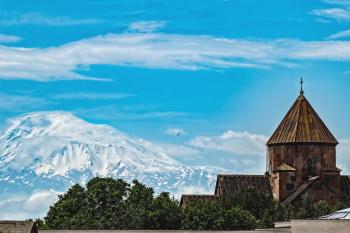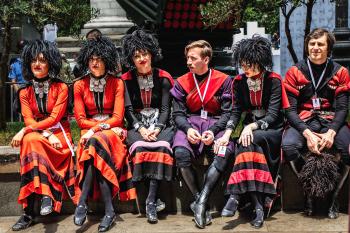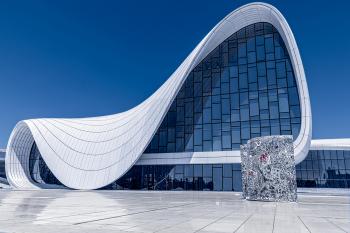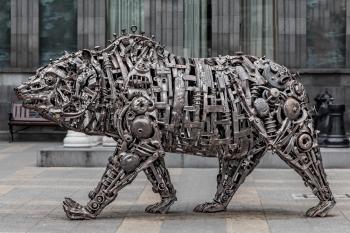Impressed with a custom tour of the Caucasus
This article appears on page 6 of the January 2019 issue.
I had been to Armenia and Georgia in 1974, when they were still part of the USSR, and when I met some fellow dermatologists from both countries at a recent meeting held in San Diego and they were kind enough to invite me to visit them, I declared the Caucasus to be my May 2018 travel destination.
Zulya Rajabova, President of Silk Road Treasure Tours, had arranged a superb trip to Uzbekistan for my wife, Yuki, and me, so she seemed the right person to call to plan this upcoming trip. She said, "Leave everything to me!" and soon sent us an initial detailed plan for review. (Our private tour cost $11,772 for the two of us.)
Arriving in Azerbaijan
We opted to fly business class from Los Angeles to Azerbaijan on Qatar Airways ($10,380 total), as it offered the least amount of time spent on layovers. The brand-new Boeing 777-200LR was very comfortable, and the food was superb, especially their spicy chicken biryani. They did provide noise-reducing headphones, but my new Sony headphones proved superior.
Throughout the flight, the attendants kept the facilities clean, which often does not happen on many other airlines, and it was much appreciated.
After a brief stopover in Doha, Qatar, we hopped on a flight to Baku, Azerbaijan, a mere three hours away.
Passport control in Azerbaijan went through our passports with a fine-tooth comb, apparently looking for any stamps from Armenia, with whom they're having some difficulties.
Our room at the Fairmont Hotel, near the top floor, had an excellent view, though it was not close to downtown. As we had our own driver, that wasn't a problem.
After a few hours of sleep, we enjoyed an excellent breakfast and set out for the Gobustan Valley, where there are famous rock etchings. Unfortunately, only a few images were visible; later, we discovered better examples that had been removed to be featured at a local museum.
Then it was off to a local hamam (bathhouse) and an old mosque, but the best part was lunch at S¸irvans¸ah Musey Restaurant (Salatin Asgerova, 86, Baku).
After visits to some Zoroastrian sites, such as the Ateshgah and Yanar Dag (which we found uninspiring), it was time to head to the airport to fly to Georgia.
Tbilisi and beyond
Following 45 minutes on a Buta Airways flight, we quickly cleared Customs in Tbilisi and were met by our guide, Nino Maghlakelidze, a bubbly, 23-year-old lady who spoke absolutely flawless English. She was brilliant, organized and funny.
Our first night in the city was spent at the Rooms Hotel, a boutique hotel with hand-sawn wooden floors — very chic and unique.
Tbilisi was celebrating its 100 years of freedom, so the streets were filled with tens of thousands of citizens, with lots of festive booths selling drinks, books and handmade tchotchkes.
We took the tramway up to the Narikala fortress, which was certainly easier than walking up. The walk down, however, was easy, and we got to see various famous sites, such as the Bridge of Peace and the monument Kartlis Deda, along the way.
Then we walked over to Sioni Cathedral, where a noted politician happened to be to receive some sort of blessing. I heard a choir singing and assumed it was a recording, but no! In the front of the church was a small group of elderly ladies in regular street clothes chanting in a most musical way. Stunning!
Dinner was at Tavaduri (2/4 Vladimer Maikovski St.), where the display of Georgian dancing was superb, but the food was just OK.
The next day, after being stuck in a traffic jam caused by several hundred sheep and goats, we arrived at the Udabno church where, after a few minutes of my trying to get up a path over rocks and boulders that only a mountain goat would like, discretion proved the better part of valor and I quickly climbed down. Our touring day continued with a brief visit to Bodbe Monastery, built to honor St. Nino, who brought Christianity to Georgia. It was dark, the paintings were faded, and a large "No photography" sign encouraged us to decamp fairly quickly.
After an overnight in Sighnaghi, we returned to Tbilisi, where we moved to another boutique hotel, Shota Rustaveli. The rooms were modern, and the bed was comfortable. While we had to wait until 8 a.m. for breakfast, it was a feast! All sorts of the usual buffet foods were offered along with chopped chicken liver, eggs Benedict (or whatever kind of eggs you wanted, made to order), wonderful salmon and more.
The next morning, our first stop was at the House Museum of Chavchavadze in Tsinandali, an old house where wealthy folks had once lived. (I'd recommend skipping a visit there.)
The Mosmieri Kakheti Wine Centre, where Yuki and I sampled five different local wines, was a lot of fun. A white wine called Tsinandali was quite drinkable, if not a 5-star wine, and the Kakhuri, sort of yellow in color, had nice, strong tannins and would be good with red meat, I think. The red wine, Saperavi, was pleasant but young and not very complex. Cheeses of varying saltiness were provided to go with the wines.
Our last stop in Georgia was Hotel Gino Wellness Rabath. It was hidden in a new pseudo-fortress, which meant we had to carry our luggage from the distant parking area to the hotel.
In short, our stay was not pleasant. There was no elevator, and the food in the adjacent restaurant was not only not as described on the menu, we found it inedible. Avoid this place at all costs.
The nearby caves of Vardzia were fairly impressive. We elected not to climb for several hours to visit them but, instead, sat in the shade by a very pleasant burbling brook, drinking coffee and talking.
Into Armenia
As we left Georgia to continue our journey in Armenia, we had to walk the half mile or so through the no-man's-land between the two countries, though our Armenian guide, Anna Tumasian, managed to drive most of the way to pick us up. Anna spoke superb English and was organized, thoughtful and caring.
It was sunny in Georgia when we left, but within a few minutes it began to rain as we entered Armenia, the blue skies quickly changing to rain and back within the space of a few hours. This happened most days during our trip.
Quick visits to the Gyumri churches of the Seven Wounds of the Holy Mother of God (also called Yot Verq) and the Holy Saviour in Vartanants Square provided some excellent photos, but then we took a 3-plus-hour ride on bad-to-worse roads to visit Armenia's "very important castle," Amberd. My advice? Don't bother.
We eventually arrived in Yerevan, the capital. Exhausted, we checked into the Marriott, located directly on Republic Square.
As Armenia, like Georgia, was celebrating its 100 years of freedom, the square was filled with thousands of citizens. There were a bunch of large, mean-looking guards in front of and behind our hotel's entrance doors who gave us a very thorough look-over as we entered — not a warm and fuzzy feeling. However, interesting restaurants and small shops as well as a very high-end shopping street were all just a few minutes away.
Having said that, I was not pleased to find that, as my travel agent had booked the hotel, I would not accrue Marriott points for staying there and could not get an upgrade. We were placed in the old part of the hotel, which required several minutes of walking before we even reached the elevators.
The hallway was shabby, with stains on the carpet in front of each room, and tobacco smoke lingered there.
Our room was huge, though, and nicely appointed, and the fireworks that night were visible from our window.
We ate at a number of excellent and inexpensive restaurants near the Marriott. Tavern Yerevan (5 Amiryan St.), Sherep Restaurant (1 Amiryan St.) and Wine Republic (2 Tamanyan St.) all offered excellent food and friendly service.
Walking in Yerevan was wonderful! The Khatoghike Church was breathtaking, and there were parks all over the city.
We treated ourselves to tickets to a dance festival about a block from the hotel; the best seats in the house cost about $10. Was it Moiseyev-level dancing? No, but it was fun.
A "must visit" in Yervan is Zvartnots Cathedral, also called St. Gregory the Illuminator Church, which dates from around 650. While there's not much left of the original structure, the engraved pillars were very impressive.
We, of course, had to visit the 13th-century Noravank Monastery, where you climb an outside staircase to get into the second story, but perhaps the best part of the whole trip was visiting our driver's brother's house, where we drank Ararat brandy and homemade vodka while snacking on goodies that his wife had prepared — one of the advantages of not being on a large group tour.
One also has to visit the Temple of Garni, the only pagan temple in Armenia, but more moving was a visit to Geghard church, with its khachkars (freestanding crosses). Down in a candlelit room there was a group of Armenians, apparently from overseas, singing sacred songs with reverberant voices. A rare treat!
We liked Armenia a lot; it was safe and clean, with nice people, great food and beautiful churches. Highly recommended.
We also highly recommend Silk Road Treasure Tours (Chester, NJ; 888/745-7670, www.silkroadtreasuretours.com). This endorsement comes from our hearts, and we're looking forward to having Zulya plan our next trip, this time to five of the 'Stans.





